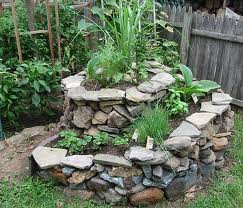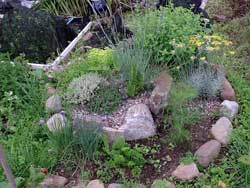Small Home Gazette, Summer 2012
Herb Spirals Are Small Yard Wonders

An herb spiral is a clever way to grow a variety of herbs, each with different environmental needs (sun, shade, moist, dry) in a minimal amount of space. If your yard is small like ours, space is always an issue.
A typical spiral size is about 6 feet across and 2 to 3 feet high. The top is quite dry and hot; the bottom is moist—and there is a sunny side and a shady side. The simplest method of construction is to pile the soil into a large heap and insert stones or bricks to create a spiral shape, adjusting the soil to fit the upward spiral path. A mixture of soil with some sand is recommended to improve drainage. Before planting the herbs, add some compost. Planting pot-grown plants as well as adding gravel around the plants will help to prevent the soil from washing away in the rain.
 The advantages of an herb spiral are:
The advantages of an herb spiral are:
- It makes use of both vertical and horizontal space, allowing you to make maximum use of a small growing area. The curved planting area also increases the space available for your plants.
- Due to its design, the spiral offers a variety of microclimates, so you can plant a wide range of herbs with differing needs.
- Having a diversity of herbs is a convenience to the cook in the family, plus some plants attract helpful insects such as bees while others deter pests.
- You can feel good about building an area that represents the principles of permaculture, a design system that models natural ecosystems.
- Finally, a spiral’s curves and height add visual interest to a garden and can provide a unique conversation piece.
 The top of the spiral is good for Mediterranean heat-loving herbs that require good drainage like rosemary, thyme or oregano. The midsections suit herbs that require a bit more moisture and somewhat richer soil such as sage, tarragon, basil or cilantro. The lowest portion is home to plants such as parsley, chive or mint, which like abundant water and soil rich in nutrients. As you probably know, for gardeners in the Northern hemisphere, the hottest side of your herb spiral will be facing south.
The top of the spiral is good for Mediterranean heat-loving herbs that require good drainage like rosemary, thyme or oregano. The midsections suit herbs that require a bit more moisture and somewhat richer soil such as sage, tarragon, basil or cilantro. The lowest portion is home to plants such as parsley, chive or mint, which like abundant water and soil rich in nutrients. As you probably know, for gardeners in the Northern hemisphere, the hottest side of your herb spiral will be facing south.
Some final tips. Choose a spot that is sunny most of the day. If you make a spiral larger than 6 feet wide by 3 feet high, you won’t be able to reach all of the plants easily, and some of the plants might get too much shade. Care for the herbs as you would those in a regular raised bed—lightly fertilize once a month or so and water during dry spells.
An Internet search on how to build an herb spiral will get you construction tips or search “herb garden permaculture” at www.youtube.com.











